Attitudes Towards Youth Crime and Willingness to Intervene: Findings from the 2006 Scottish Social Attitudes Survey
This report presents findings from a module of questions included in the 2006 Scottish Social Attitudes survey and revisits a theme first addressed by survey in 2004, namely public attitudes towards young people and youth crime.
CHAPTER TWO TRUST, CONNECTEDNESS AND INTER-GENERATIONAL CONTACT
Introduction
2.1 By way of context, the module included a small number of measures of social trust, 'social connectedness' and inter-generational contact - concepts that are clearly linked to wider debates around issues such as collective efficacy, reciprocity, social cohesiveness and social capital. These are examined in this chapter in their own right and used in subsequent chapters as potential explanatory variables in relation to views of young people and youth crime and expressed willingness to intervene.
2.2 Why might these factors matter in the context of willingness to intervene? It is reasonable to hypothesise that informal social control might be exercised more readily in a context of greater social cohesion and what has been termed 'density of acquaintanceship' (Freudenberg, 1986). Not only might this mean that adults are more likely to have some point of contact with the young people whose behaviour is considered problematic ( e.g. they might know them as the children of friends, neighbours or workmates); it might also give them greater confidence that their reading of the situation (and of the basis for intervention) is likely to be shared by others. A culture of trust and reciprocity might also be hypothesised to be supportive of informal social control, since it may set up expectations around mutual aid and provide reassurance about people's motives when intervening.
Measures of reciprocity and social connectedness
2.3 To tap experiences and perceptions of reciprocity and 'social connectedness', respondents were asked to what extent they agreed or disagreed with the following statements.
- I have friends or relatives in this area I feel I could turn to for advice or support
- If my home was empty, I could count on one of my friends or relatives in this area to keep an eye on it
- I regularly stop and speak to people in my area
2.4 The results for the sample as a whole are summarised in the following table.
Table 1 - Measures of social connectedness
Agree strongly |
Agree |
Neither agree nor disagree |
Disagree |
Disagree strongly |
Sample size |
|
|---|---|---|---|---|---|---|
% |
% |
% |
% |
% |
||
I have friends or relatives in this area I feel I could turn to for advice or support |
39 |
45 |
3 |
11 |
3 |
1594 |
If my home was empty, I could count on one of my friends or relatives in this area to keep an eye on it |
44 |
47 |
2 |
5 |
2 |
1594 |
I regularly stop and speak to people in my area |
28 |
54 |
8 |
9 |
1 |
1594 |
2.5 Overall, the results suggest that most people feel they do have a reasonable degree of social support and connectedness in their local community, though the proportion agreeing strongly with the last statement is markedly lower than for the other two. This suggests that social connectedness cannot be reduced to 'density of acquaintanceship' and that individuals may have strong networks of help and support within their own community without necessarily knowing everybody within it.
2.6 There are also some variations of note across the different sub-groups. On all three measures, women were more likely than men to agree strongly - an indication, perhaps, that women are more connected to their local communities through childcare in particular. In relation to age, the picture is slightly more complicated. In general, those in the younger age groups were more likely to agree strongly with the first statement, while those in the middle age group were more likely to agree strongly with the second. Those in the oldest age group were relatively more likely, however, to agree with the third. In other words, the three statements appear to be tapping different dimensions of social cohesion and reciprocity and experience of these appears to vary across the lifecourse.
2.7 Those on lower incomes and in areas of highest deprivation 2 were no less likely to stop and speak to people in the street, but were less likely to have friends, family or neighbours to whom they can turn for help or support. In other words, such individuals and areas may be characterised by breadth rather than depth of 'connectedness'. Any suggestion that the areas of greatest deprivation are nevertheless characterised by high levels of neighbourliness and cohesiveness is also roundly disproved: on all three measures, those living in the most deprived quintile exhibit the lowest levels of connectedness and cohesiveness.
2.8 In order to summarise these variations across different groups, a 'connectedness' scale was created from the three measures outlined above, yielding a maximum score of 15 and a minimum score of 3. Respondents were then assigned to tertiles, labelled in the following analysis as 'most connected,' 'intermediate' and 'least connected'. The following table shows those variables which (on the basis of logistic regression) are independently and significantly associated with belonging to the 'most connected' group. This highlights the powerful association between household income and social connectedness with those in more affluent households significantly more likely to belong to the 'most connected' group. Those who perceive problems with youth crime to be less common are also more likely to feature in the 'most connected' group.
Table 2 - Social connectedness by key variables (row percentages)
Most connected |
Intermediate |
Least connected |
Sample size |
|
|---|---|---|---|---|
% |
% |
% |
||
All |
34 |
39 |
27 |
1594 |
Sex |
||||
Male |
27 |
42 |
31 |
701 |
Female |
39 |
37 |
24 |
893 |
Age |
||||
18-24 |
31 |
32 |
38 |
108 |
25-34 |
39 |
32 |
30 |
222 |
35-44 |
41 |
33 |
26 |
325 |
45-54 |
34 |
43 |
24 |
270 |
55-64 |
26 |
46 |
29 |
270 |
65+ |
30 |
48 |
22 |
396 |
Contact with 11 to 15 year-olds |
||||
Know most |
44 |
40 |
16 |
226 |
Know none |
26 |
39 |
35 |
757 |
Contact with 16 to 24 year-olds |
||||
Know most |
42 |
41 |
17 |
241 |
Know none |
23 |
38 |
39 |
631 |
Income |
||||
Lowest quintile |
22 |
44 |
34 |
399 |
Highest quintile |
39 |
35 |
26 |
236 |
Perceptions of youth crime problems |
||||
Least common |
36 |
37 |
28 |
489 |
Most common |
30 |
40 |
30 |
464 |
Social trust
2.9 The survey also included a simple measure of social trust, which has been used extensively in previous sweeps of the survey. This simply asks respondents to choose which of two statements is closest to their view: 'most people can be trusted' or 'you can't be too careful these days'. Interestingly, the results do not map neatly onto the measures of social connectedness outlined above. Indeed, although women were more likely than men to agree with each of the statements relating to reciprocity/connectedness, they were less likely to agree that most people can be trusted. The results in relation to age are even more striking, with older age groups much more likely than younger ones to exhibit social trust, despite the fact that they appear to be less closely connected to those around them. This is also, perhaps, a finding that confounds conventional wisdom about increasing social mistrust and isolation among older people and, in doing so, begs the question of whether this is a lifecourse or a cohort effect. In other words, do people become more trusting as they get older, or does the current cohort of older people simply belong to a generation that has always been more trusting than those that followed?
Figure 1 - Social trust - 'most people can be trusted' - by age group and gender (%)
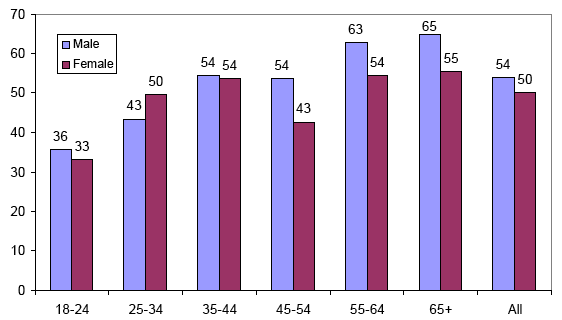
Sample size - 1587
2.10 As the results from regression modelling demonstrate (see Table 3), it is also clear that social trust is generally much greater among home owners, those with higher levels of educational attainment, those in higher income households and living in areas of least deprivation. For example, among those in the least deprived quintile, the proportion saying that 'most people can be trusted' was 61%; among those in the most deprived, it was just 37%. There is also a clear link to overall social connectedness.
Table 3 - Social trust by key variables (row percentages)
Most people can be trusted |
Can't be too careful |
Don't know |
Sample size |
|
|---|---|---|---|---|
% |
% |
% |
||
All |
52 |
44 |
5 |
1594 |
Social connectedness |
||||
Most connected |
55 |
41 |
4 |
546 |
Least connected |
43 |
53 |
4 |
417 |
Area deprivation |
||||
Least deprived |
61 |
36 |
3 |
319 |
Most deprived |
37 |
58 |
5 |
307 |
Tenure |
||||
Owner-occupier |
57 |
39 |
5 |
1088 |
Social renter |
37 |
59 |
4 |
373 |
Age |
||||
18-24 |
35 |
56 |
9 |
108 |
25-34 |
47 |
48 |
5 |
222 |
35-44 |
54 |
42 |
4 |
325 |
45-54 |
48 |
46 |
6 |
270 |
55-64 |
59 |
39 |
2 |
270 |
65+ |
59 |
38 |
2 |
396 |
Highest educational qualification |
||||
Degree/Higher Education |
59 |
35 |
6 |
479 |
None |
43 |
53 |
4 |
394 |
Income |
||||
Lowest quintile |
42 |
56 |
3 |
399 |
Highest quintile |
63 |
34 |
4 |
236 |
Measures of inter-generational contact
2.11 A key theme in the 2004 module was inter-generational contact, which was found to be strongly associated with attitudes towards young people.
2.12 This issue was revisited in the 2006 survey, through two main types of measure. First of all, from background demographic data collected as part of the survey, it is possible to establish whether or not respondents live in households that contain young people. Secondly, the survey asked respondents how many of the young people in their area - apart from close relatives or household members - they would know well enough to speak to.
2.13 The findings reinforce the picture emerging from the 2004 module: that young people are by no means a 'tribe apart', but that there are significant gaps in contact.
Household composition and parent-child links
2.14 The most direct way in which adults come into contact with young people is through their own households and family relationships. Overall, 12% of those interviewed lived in a household containing at least one person aged 11-15 while 20% lived with someone aged 16-24. Ten per cent and 12%, respectively, had children (or step-children) in those particular age groups.
2.15 For the most part, the picture here is entirely as one might expect. Those aged 35 to 54 ( i.e. of typical parenting age) are by far the most likely to live with someone aged 11 to 15.
Figure 2 - Resident in household containing young person by age group (%)
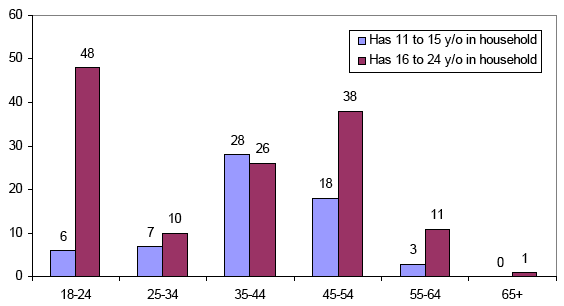
Sample size: 1594
2.16 But perhaps the most striking finding here is the almost complete absence of multi-generational households containing both young people and those in the oldest age group. Although we have no easily available comparative data here, it seems unlikely that the same results would have been obtained some 30 or 40 years ago. It also means that there may be a fundamental structural difficulty to be overcome in establishing close relationships between the oldest and youngest sections of the population. That said, many older people do have links with younger people through grandparenting - an issue we return to below.
Contact with young people in area
2.17 The survey also included a set of questions aimed at gauging respondents' levels of contact with young people in their area. For 11 to 15 year-olds, 16 to 24 year-olds and also - for reasons of comparability - people aged over 25, respondents were asked whether they knew 'most', 'some' or 'none' well enough to speak to in the street.
2.18 The results again suggest that there are some significant gaps in inter-generational contact.
Figure 3 - Contact with 11 to 15 year-olds in area by age group (%)
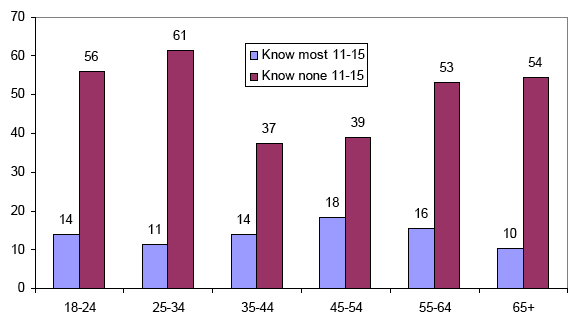
Sample size: 1594
Figure 4 - Contact with 16 to 24 year-olds in area by age group (%)
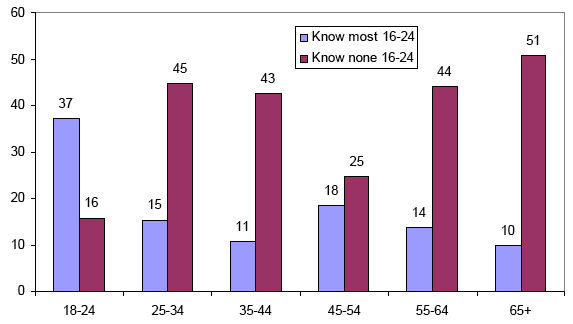
Sample size: 1594
2.19 Again, this serves to emphasise the way in which inter-generational contact is patterned by lifestage rather than age per se. The proportion of adults between the ages of 18 and 34 who know 'none' of the 11 to 15 year-olds in their area is much higher than in the two subsequent age groups (who are the most likely to have children of their own in that age bracket) and indeed than that among the oldest age groups. The same pattern does not, of course, hold for contact with 16 to 24 year-olds, since the youngest age group covered by the survey largely coincides with this group.
2.20 Other factors independently associated with extent of contact with the 11 to 15 year-olds in the area were tenure (those in social rented accommodation were more likely than either home owners or private renters to know 'most'), area deprivation (those in more deprived areas were more likely to know most) and extent of general social connectedness. The following figure shows the relationship between contact with young people (aged 11 to 15 and 16 to 24) and the social connectedness scale described earlier in this chapter.
Figure 5 - Contact with 11 to 15 year-olds in area by 'social connectedness' scale (%)
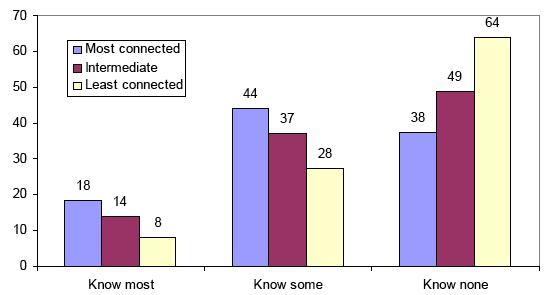
Sample size: 1594
2.21 For the first time in the 2006 survey, respondents were asked about how they came into contact with young people in their area.
Table 4 - Reasons for contact with young people in area (%)
11 to 15 |
16 to 24 |
|
|---|---|---|
% |
% |
|
I have other close relatives this age |
31 |
27 |
I meet people in neighbourhood |
29 |
32 |
I meet child/grandchild's friends |
14 |
11 |
I have grandchildren |
13 |
8 |
I have children this age |
11 |
11 |
I meet people this age at work |
10 |
25 |
I meet people in clubs/groups |
7 |
12 |
I volunteer with young people |
5 |
2 |
I myself have friends |
4 |
18 |
Other reason |
3 |
2 |
I don't have any contact |
28 |
21 |
Sample size |
1594 |
1594 |
2.22 Although around three in ten indicated that they simply meet young people in their neighbourhood, most responses related to family ties of various kinds. Grandparenting is especially significant in relation to those aged 65 and over, with 39% of respondents indicating that they have a grandchild between the ages of 11 and 15. In the absence of genuinely multi-generational households, such links may have a particular significance. Not surprisingly, the proportion of respondents saying they work with young people or have friends of that age was higher in relation to the 16 to 24 year-old age group.
Key points
- The results suggest that most people feel they have a reasonable degree of social support and 'connectedness' within their own communities - though this may be based on relatively few, strong relationships with friends and families rather than on a broader 'density of acquaintanceship'.
- Women are more likely than men to exhibit higher levels of social connectedness, as are people in higher income households. General levels of social connectedness are also associated with higher levels of inter-generational contact. Older people do not appear to be especially disconnected, scoring higher than other age groups on some measures but lower on others.
- Older people do score much more highly on the survey measure of social trust, as do men, despite their lower levels of social connectedness. Social trust is also markedly higher among those with higher levels of educational attainment, in higher income households and living in areas of least deprivation.
- The two main measures of inter-generational contact (based on household structure and level of contact with young people in the area) vary greatly according to lifestage, rather than age per se, with the highest levels of contact associated with those most likely to have children aged between 11 and 24 .
- There are clearly some very significant gaps in contact between the oldest and the youngest age groups - exacerbated by the almost complete absence of households spanning more than two generations - but a sizeable minority of the 65 plus age group do have links through grandchildren of that age.
- Although around three in ten adults say that they come into contact with young people simply by meeting them in their neighbourhood, for most, inter-generational contact is structured around family ties of various kinds.
There is a problem
Thanks for your feedback